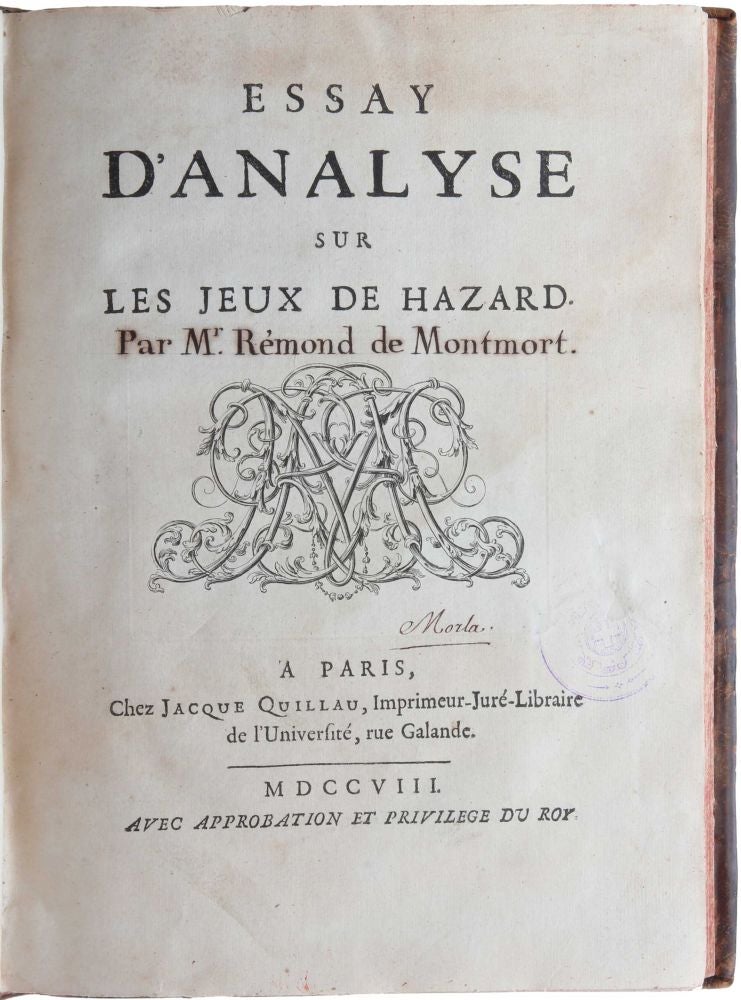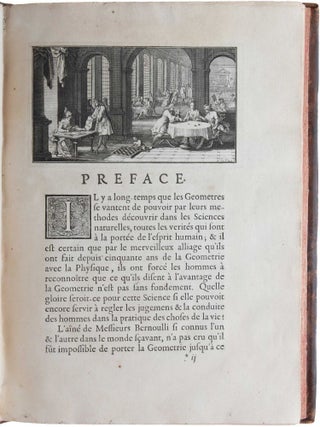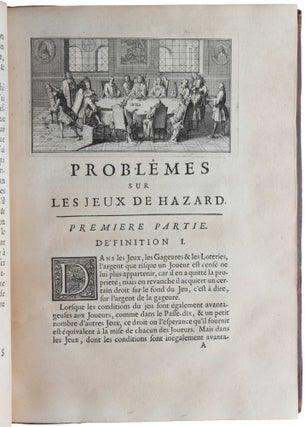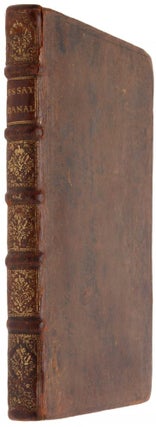Essay d'Analyse sur les Jeux de Hazard.
Paris: Jacque Quillau, 1708. First edition, first issue, very rare, of the first separately published textbook of probability. This issue has significant textual differences from what is usually referred to as the first edition. “In 1708 [Montmort] published his work on Chances, where with the courage of Columbus he revealed a new world to mathematicians” (Todhunter, p. 78). “The Essay (1708) is the first published comprehensive text on probability theory, and it represents a considerable advance compared with the treatises of Huygens (1657) and Pascal (1665). Montmort continues in a masterly way the work of Pascal on combinatorics and its application to the solution of problems on games of chance. He also makes effective use of the methods of recursion and analysis to solve much more difficult problems than those discussed by Huygens. Finally, he uses the method of infinite series, as indicated by Bernoulli (1690)” (Hald, p. 290). “Montmort’s book on probability, Essay d’analyse sur les jeux de hazard, which came out in 1708, made his reputation among scientists” (DSB). Based on the problems set forth by Huygens in his De Ratiociniis in Ludo Aleae (1657) (published as an appendix to Frans van Schooten’s Exercitationum mathematicarum), the Essay spawned Abraham de Moivre’s two important works De Mensura Sortis (1711) and Doctrine of Chances (1718). ABPC/RBH record the sale of just three other copies of the first edition (Christie’s 1981, Hartung 1987 and the Tomash copy). As Sotheby’s correctly noted in the Tomash library sale catalogue (18 September 2018, lot 434), “This book was first issued in 1708 without illustrations and an uncorrected text,” and indeed the three large folding tables found in the regular issue are not present in this first issue, which also has a shorter list of errata than the regular issue. The existence of two textually different issues of this work, both published in 1708, has not, as far as we are aware, been noted in the academic literature. The modern theory of probability is generally agreed to have begun with the correspondence between Pierre de Fermat and Blaise Pascal in 1654 on the solution of the ‘Problem of points’; this was published in Fermat’s Varia Opera (1679). Pascal included his solution as the third section of the second part of his 36-page Traité du triangle arithmétique (1665), which was essentially a treatise on pure mathematics. “Huygens heard about Pascal’s and Fermat’s ideas [on games of chance] but had to work out the details for himself. His treatise De ratiociniis in ludo aleae … essentially followed Pascal’s method of expectation. … At the end of his treatise, Huygens listed five problems about fair odds in games of chance, some of which had already been solved by Pascal and Fermat. These problems, together with similar questions inspired by other card and dice games popular at the time, set an agenda for research that continued for nearly a century. The most important landmarks of this work are Bernoulli’s Ars conjectandi (1713), Montmort’s Essay d'analyse sur les jeux de hazard (editions in 1708 and 1711 [i.e., 1713]) and De Moivre’s Doctrine of Chances (editions in 1718, 1738, and 1756). These authors investigated many of the problems still studied under the heading of discrete probability, including gamblers ruin, duration of play, handicaps, coincidences and runs. In order to solve these problems, they improved Pascal and Fermat’s combinatorial reasoning, summed infinite series, developed the method of inclusion and exclusion, and developed methods for solving the linear difference equations that arise in using Pascal’s method of expectations.” (Glenn Schafer in Companion Encyclopedia of the History and Philosophy of the Mathematical Sciences (1994), Grattan-Guiness (ed.), p. 1296). “It is not clear why Montmort undertook a systematic exposition of the theory of games of chance. Gaming was a common pastime among the lesser nobility whom he frequented, but it had not been treated mathematically since Christiaan Huygens’ monograph of 1657. Although there had been isolated publications about individual games, and occasional attempts to come to grips with annuities, Jakob I Bernoulli’s major work on probability, the Ars conjectandi, had not yet been published. Bernoulli’s work was nearly complete at his death in 1705; two obituary notices give brief accounts of it. Montmort set out to follow what he took to be Bernoulli’s plan … [Montmort] continued along the lines laid down by Huygens and made analyses of fashionable games of chance in order to solve problems in combinations and the summation of series” (DSB). “In this first edition of the Essai d'Analyse Montmort begins by finding the chances involved in various games of cards. He discusses such simple games as Pharaoh, Bassette, Lansquenet and Treize, and then, not so fully or successfully, Ombre and Picquet. The work is easy to read in that he prefaces each section with the rules of the game discussed, so that what he is trying to do can be explicitly understood. Possibly he found it necessary to do this because different versions of the games were in vogue, but this does not always occur to other writers. Having set down the rules, he solves simple cases in a method somewhat reminiscent of Huygens, and then takes a plunge into a general solution which appears to be correct but is not always demonstrably so. The Problèmes divers sur le jeu du treize are interesting indeed in that he gives the matching distribution and its exponential limit. Treize has survived today as the children's game of Snap. ‘The players draw first of all as to who shall be the Bank. Let us suppose that this is Pierre, and the number of players whatever one likes. Pierre having a complete pack of 52 shuffled cards, turns them up one after the other. Naming and pronouncing one when he turns the first card, two when he turns the second, three when he turns the third, and so on until the thirteenth which is the King. Now if in all this proceeding there is no card of rank agreeing with the number called, he pays each one of the Players taking part and yields the Bank to the player on his right. But if it has happened in the turning of the thirteen cards that there has been an agreement, for example turning up an ace at the time he has called one, or a two at the time he has called two, or three when he has called three, he takes all the stakes and begins again as before calling one, then two, etc.’ “He begins by assuming Pierre has two cards and one opponent, Paul. Then Pierre has three cards, four, and finally any number [say, p] … He gives p successively values 1, 2, ... , 13 and calculates Pierre's chance at each stage. It is, however, the remarks on this which are interesting. After his calculations he says: ‘The preceding solution furnishes a singular use of the figurate numbers (of which I shall speak later), for I find in examining the formula, that Pierre's chance is expressible by an infinite series of terms which have alternate + and – signs … we have for Pierre's chance the very simple 1/1 - 1/1.2 + 1/1.2.3 - 1/1.2.3.4 + 1/1.2.3.4.5 - 1/1.2.3.4.5.6 + etc.’ “This is possibly the first exponential limit in the calculus of probability … [the sum of the series is 1/e, where e is the base of natural logarithms]. “In the second half of the first part on Piquet, Ombre, etc. he interpolates a section on problems in combinations. This is all quite sound mathematics, although he takes a very long time to establish the Arithmetic Triangle. The principle of conditional probability, often attributed to de Moivre but probably dating back to the controversy between Huygens and Hudde, is used with facility and understanding … “In the second part of his treatise Montmort discusses the game of Quinquenove and the game of Hazard, remarking about the latter that the game is known only in England … Montmort gives the chances of [the two players in Hazard] and then describes another game, which he says has no name and so he dubs it the game of Hope, and gives some calculations on this also. Backgammon however rather defeats him … “From an historical point of view, however, there is interest in his game of Nuts … divination among primitive tribes is (and was) carried out by casting pebbles, grain, or nuts, etc. It is also still a puzzle that the same ritual of divination was used in games to while away the idle hour. That this duality of purpose was probably universal, not just European, appears likely from Montmort's discussion on Problème sur le Jeu des Sauvages, appellee Jeu des Noyaux. He writes: ‘Baron Hontan mentions this game in the second book on his travels in Canada, p. 113 [Nouveaux voyages dans l’Amérique septentrionale, 1703]. This is how he explains it. It is played with eight nuts black on one side and white on the other. The nuts are thrown in the air. If the number of black is odd, he who has thrown the nuts wins the other gambler's stake. If they are all black or all white he wins double stakes, and outside these two cases he loses his stake.’ “Having solved the problem for four-sided nuts he concludes his book with Huygens' five problems, and some reflections on the games of Her, Ferme and Tas” (David, pp. 144-150). “The greatest value of Montmort’s book lay perhaps not in its solutions but in its systematic setting out of problems about games, which are shown to have important mathematical properties worthy of further work. The book aroused Nikolaus I Bernoulli’s interest in particular and the 1713 edition includes the mathematical correspondence of the two men. This correspondence in turn provided an incentive for Nikolaus to publish the Ars conjectandi of his uncle Jakob I Bernoulli … “The work of De Moivre is, to say the least, a continuation of the inquiries of Montmort. Montmort put the case more strongly—he accused De Moivre of stealing his ideas without acknowledgment. De Moivre’s De mensura sortis appeared in 1711 and Montmort attacked it scathingly in the 1713 edition of his own Essay. Montmort’s friends tried to soothe him, and largely succeeded. He tried to correspond with De Moivre, but the latter seldom replied. In 1717 Montmort told Brook Taylor that two years earlier he had sent ten theorems to De Moivre; he implied that De Moivre could be expected to publish them” (DSB). “The value of Montmort’s work resides partly in his scholarship. He was well-versed in the work of chance of his predecessors (Pascal, Fermat, Huygens), met Newton on one of a number of visits to England, corresponded with Leibniz, but remained on good terms with both sides during the strife between their followers. The summation of finite series is an element of Montmort’s mathematical interests which enters into his probability work and distinguishes it from the earlier purely combinatorial problems arising out of enumeration of equiprobable sample points. Although the Essay to a large extent deals with the analysis of popular gambling games, it focuses on their mathematical properties and is thus written for mathematicians rather than gamblers … Montmort also worked with Nicolaus [I Bernoulli] on the problem of duration of play in the gambler’s ruin problem, possibly prior to de Moivre, and at the time the most difficult problem solved in this subject area” (Heyde & Seneta, Statisticians of the Centuries, p. 53). “Pierre Rémond de Montmort (1678-1719) was born into a wealthy family of the French nobility. As a young man he traveled in England, the Netherlands, and Germany. Shortly after his return to Paris in 1699 his father dies and left him a large fortune. He studied Cartesian philosophy under Malebranche and studied the calculus on his own. … Montmort corresponded with Leibniz whom he greatly admired. He was also on good terms with Newton whom he visited in London. In 1709 he printed 100 copies of Newton’s De Quadratura at his own expense … through John Bernoulli, he also offered to print Ars Conjectandi. He was on friendly terms with Nicholas Bernoulli and Brook Taylor” (Hald, pp. 286-7). The Royal Society elected Montmort a Fellow in 1715 and the Academic Royale des Sciences made him an associate member (as he was not a resident of Paris) the following year. The textual differences between the issue offered here, which we shall call Ia, and what is usually referred to as the first edition, which we shall call Ib, are very substantial. They begin already on page 3 of the text. In Ia the last two paragraphs preceding Proposition 1 read: ‘Car il faut remarquer que quoiqu’il soit tres incertain si Paul gagnera, & qu’il n’y ait pas même de contradiction qu’il gagne mille fois de suite, il est neanmoins tres certain que pour acheter le droit de Pierre il faudroit lui donner quarante sols, & que si Paul s’obligeoit de jouer trois coups aux conditions précedents, Pierre pourroit aussi-bien compter sur deux écus de profit, comme sur deux écus qu’il auroit tirés de sa poche, pour les risquer à pair ou à non contre deux autres écus. ‘Quoique ces termes, avantage & disavantage, semblent être clairs, parcequ’ils sont communs & familiers, j’ai crû qu’il étoit à propos pour ôter toute équivoque, d’expliquer de quelle maniere je les entends.’ In Ib, these paragraphs read: ‘Car il faut remarquer que quoiqu’il soit très incertain si Paul gagnera ou ne gagnera pas, & qu’il n’y ait point de contradiction qu’il gagne mille fois de suite, il est neanmoins très certain que pour acheter le droit de Pierre il faudroit lui donner quarante sols, & que si Paul s’obligeoit de jouer trois coups aux conditions précedents, Pierre pourroit aussi-bien compter sur deux écus de profit, comme sur deux écus que Paul lui auroit donné en pur don, à condition qu’il voulût jouer trois écus contre lui à croix ou pile. ‘Quoique ces termes avantage & disavantage semblent être clairs, parcequ’ils sont communs & familiers, j’ai crû qu’il étoit à propos pour ôter toute équivoque, d’expliquer de quelle maniere je les entends; il m’a paru que presque tout le monde y attachoit de fausses idées.’ In Ia, the statement of ‘Proposition 1. Lemme’ reads: ‘Si le nombre des hazards qui peuvent me donner a est exprime par n, & le nombre des hazards qui peuvent me donner b exprime par m, mon sort sera na + mb / n + m,’ while in Ib we have the significantly different (and italicized) statement: ‘Le nombre des hazards qui peuvent faire gagner Pierre, & lui donner A, étant m; & le nombre des hazards qui peuvent le faire perdre ou lui donner zéro, étant n, je dis que s’il n’y a que ces deux sortes de hazards, & qu’on etende par A l’argent du jeu, on aura le sort de Pierre = mA + nx0 / m + n.’ There are further substantial differences on page 4. We have not attempted to catalogue all the differences between Ia and Ib, but we note that Ib has a 15-line list of errata, the last referring to p. 166, but Ia has only an 11-line list going as far as p. 113. The nature of the changes, the absence of the plates, and the shorter errata list clearly indicate that Ia is the first issue. Goldsmiths’-Kress no. 04527.0-2, suppl.; Sotheran 3059 (‘rare’). For detailed accounts of the work see David, Games, Gods and Gambling (1962), Chap. 14; Hald, A History of Probability and Statistics and their Applications before 1750, Chap. 18; Todhunter, History of the Theory of Probability (1867), Chap. 7.
4to (249 x 180 mm), pp. xxiv, 189, [3]. Contemporary calf, spine richly gilt, some light wear to joints and spine. Engraved vignette on title, author's name added in fine manuscript (the work was published anonymously), several headpieces showing gambling scenes, and two engraved figures in text of the backgammon board (light browning to some gatherings, old library stamp partially removed from title).
Item #4632
Price: $14,000.00





